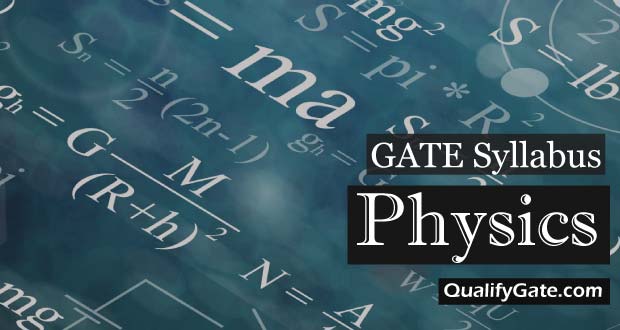GATE 2020 Syllabus for Physics pdf file download link is given below.
Syllabus for General Aptitude (GA) (common to all papers)
GATE 2020 Syllabus for Physics Section 1
Mathematical Physics
Linear vector space: basis, orthogonality and completeness; matrices; vector calculus; linear differential equations; elements of complex analysis: Cauchy-Riemann conditions, Cauchy’s theorems, singularities, residue theorem and
applications; Laplace transforms, Fourier analysis; elementary ideas about tensors: covariant and contravariant tensor, Levi-Civita and Christoffel symbols.
GATE 2020 Syllabus for Physics Section 2
Classical Mechanics
D’Alembert’s principle, cyclic coordinates, variational principle, Lagrange’s equation of motion, central force and scattering problems, rigid body motion; small oscillations, Hamilton’s formalisms; Poisson bracket; special theory of
relativity: Lorentz transformations, relativistic kinematics, mass‐energy equivalence.
GATE 2020 Syllabus for Physics Section 3
Electromagnetic Theory
Solutions of electrostatic and magnetostatic problems including boundary value problems; dielectrics and conductors; Maxwell’s equations; scalar and vector potentials; Coulomb and Lorentz gauges; Electromagnetic waves and their reflection, refraction, interference, diffraction and polarization; Poynting vector, Poynting theorem, energy and momentum of electromagnetic waves; radiation from a moving charge.
GATE 2020 Syllabus for Physics Section 4
Quantum Mechanics
Postulates of quantum mechanics; uncertainty principle; Schrodinger equation; one-, two- and three dimensional potential problems; particle in a box, transmission through one dimensional potential barriers, harmonic oscillator, hydrogen atom; linear vectors and operators in Hilbert space; angular momentum and spin; addition of angular momenta; time independent perturbation theory; elementary scattering theory.
GATE 2020 Syllabus for Physics Section 5
Thermodynamics and Statistical Physics
Laws of thermodynamics; macrostates and microstates; phase space; ensembles; partition function, free energy, calculation of thermodynamic quantities; classical and quantum statistics; degenerate Fermi gas; black body radiation and Planck’s distribution law; Bose‐Einstein condensation; first and second order phase transitions, phase equilibria, critical point.
Atomic and Molecular Physics
Spectra of one‐ and many‐electron atoms; LS and jj coupling; hyperfine structure; Zeeman and Stark effects; electric dipole transitions and selection rules; rotational and vibrational spectra of diatomic molecules; electronic transition in diatomic molecules, Franck‐Condon principle; Raman effect; NMR, ESR, X-ray spectra; lasers: Einstein coefficients, population inversion, two and three level systems.
Solid State Physics & Electronics
Elements of crystallography; diffraction methods for structure determination; bonding in solids; lattice vibrations and thermal properties of solids; free electron theory; band theory of solids: nearly free electron and tight binding models; metals, semiconductors and insulators; conductivity, mobility and effective mass; optical, dielectric and magnetic properties of solids; elements of superconductivity: Type-I and Type II superconductors, Meissner effect, London equation.
Semiconductor devices: diodes, Bipolar Junction Transistors, Field Effect Transistors; operational amplifiers: negative feedback circuits, active filters and oscillators; regulated power supplies; basic digital logic circuits, sequential circuits, flip‐flops, counters, registers, A/D and D/A conversion.
Nuclear and Particle Physics
Nuclear radii and charge distributions, nuclear binding energy, Electric and magnetic moments; nuclear models, liquid drop model: semi‐empirical mass formula, Fermi gas model of nucleus, nuclear shell model; nuclear force and two nucleon problem; alpha decay, beta‐decay, electromagnetic transitions in nuclei; Rutherford scattering, nuclear reactions, conservation laws; fission and fusion; particle accelerators and detectors; elementary particles, photons, baryons, mesons and leptons; quark model.

